An Analytical Literature Review on Customer Expectation Study
VerifiedAdded on 2023/06/05
|18
|3589
|431
Literature Review
AI Summary
This assignment presents a comprehensive literature review on customer expectations in online gaming. It details the research process, starting with a broad scan of various sources like Google Scholar and VU Libraries, followed by a focused review that filters relevant papers. The review delves into key topics such as customer preferences, willingness to pay (WTP), and the impact of game attributes on customer expectations. Conjoint analysis is discussed as a method to evaluate these attributes. The study also touches upon exceeding customer service expectations through outsourcing, providing a structured outline of the literature review chapter and an introduction to the topic. This assignment highlights the importance of understanding customer expectations for online gaming businesses to succeed in a competitive environment and is available for review and study on Desklib, a platform offering study tools and resources for students.
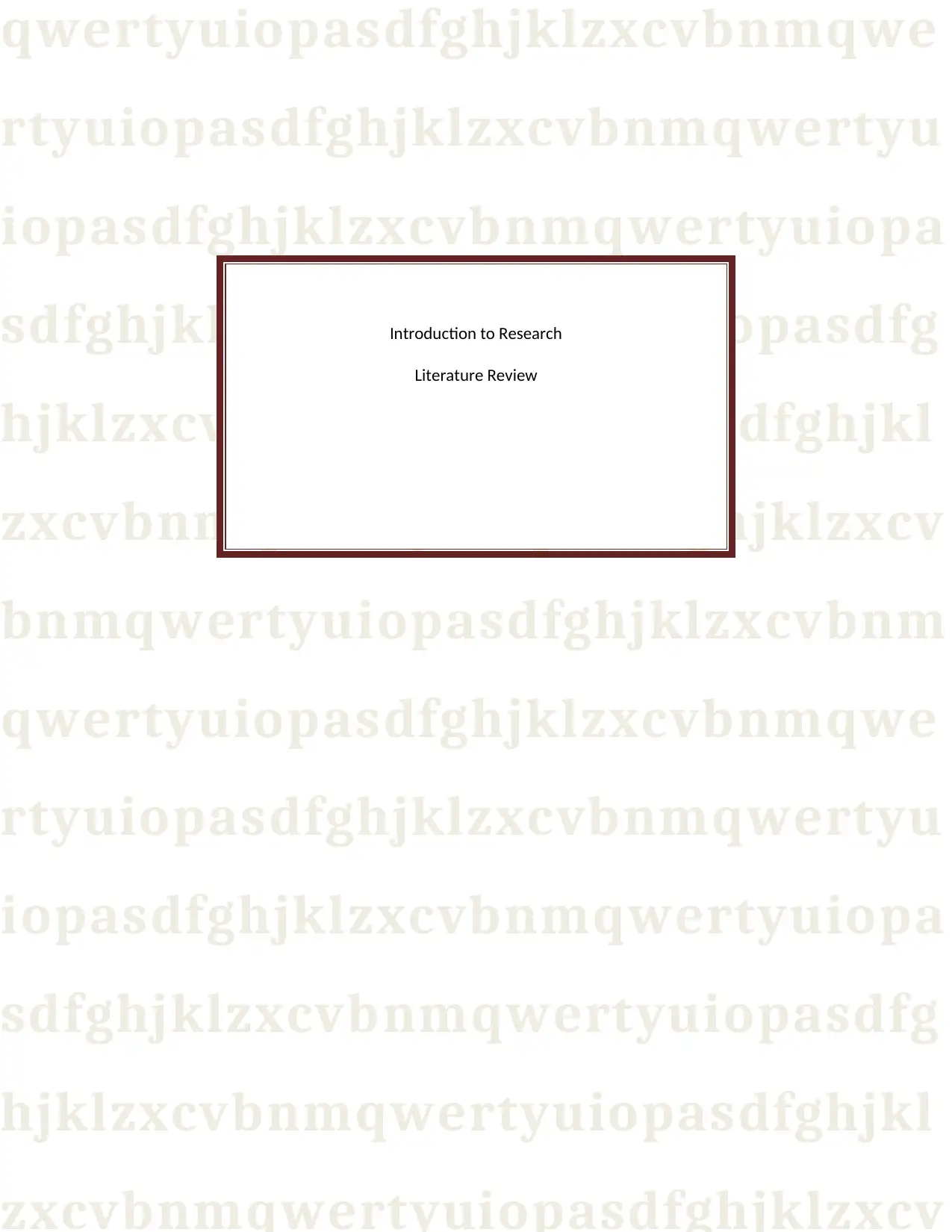
qwertyuiopasdfghjklzxcvbnmqwe
rtyuiopasdfghjklzxcvbnmqwertyu
iopasdfghjklzxcvbnmqwertyuiopa
sdfghjklzxcvbnmqwertyuiopasdfg
hjklzxcvbnmqwertyuiopasdfghjkl
zxcvbnmqwertyuiopasdfghjklzxcv
bnmqwertyuiopasdfghjklzxcvbnm
qwertyuiopasdfghjklzxcvbnmqwe
rtyuiopasdfghjklzxcvbnmqwertyu
iopasdfghjklzxcvbnmqwertyuiopa
sdfghjklzxcvbnmqwertyuiopasdfg
hjklzxcvbnmqwertyuiopasdfghjkl
zxcvbnmqwertyuiopasdfghjklzxcv
Introduction to Research
Literature Review
rtyuiopasdfghjklzxcvbnmqwertyu
iopasdfghjklzxcvbnmqwertyuiopa
sdfghjklzxcvbnmqwertyuiopasdfg
hjklzxcvbnmqwertyuiopasdfghjkl
zxcvbnmqwertyuiopasdfghjklzxcv
bnmqwertyuiopasdfghjklzxcvbnm
qwertyuiopasdfghjklzxcvbnmqwe
rtyuiopasdfghjklzxcvbnmqwertyu
iopasdfghjklzxcvbnmqwertyuiopa
sdfghjklzxcvbnmqwertyuiopasdfg
hjklzxcvbnmqwertyuiopasdfghjkl
zxcvbnmqwertyuiopasdfghjklzxcv
Introduction to Research
Literature Review
Paraphrase This Document
Need a fresh take? Get an instant paraphrase of this document with our AI Paraphraser
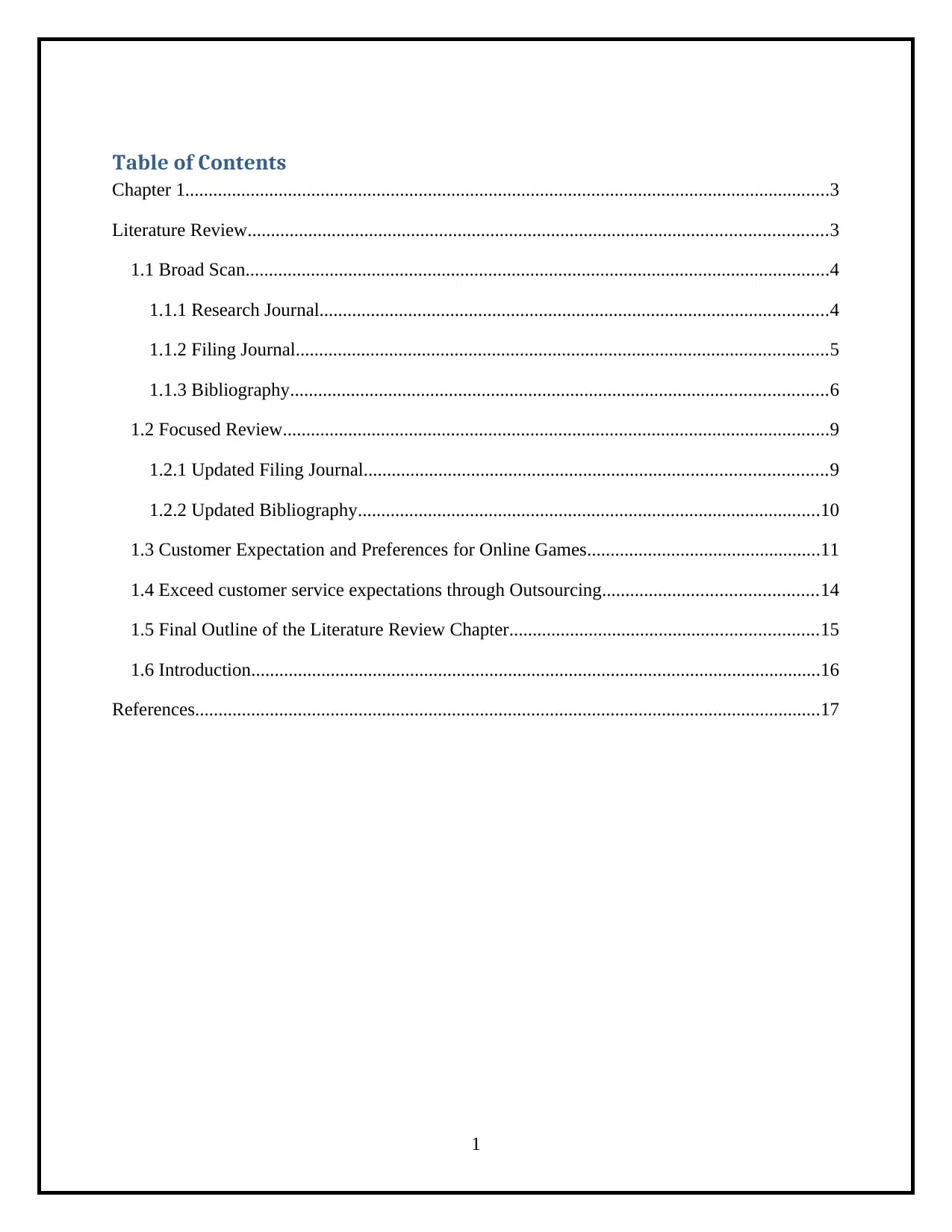
Table of Contents
Chapter 1..........................................................................................................................................3
Literature Review............................................................................................................................3
1.1 Broad Scan.............................................................................................................................4
1.1.1 Research Journal.............................................................................................................4
1.1.2 Filing Journal..................................................................................................................5
1.1.3 Bibliography...................................................................................................................6
1.2 Focused Review.....................................................................................................................9
1.2.1 Updated Filing Journal...................................................................................................9
1.2.2 Updated Bibliography...................................................................................................10
1.3 Customer Expectation and Preferences for Online Games..................................................11
1.4 Exceed customer service expectations through Outsourcing..............................................14
1.5 Final Outline of the Literature Review Chapter..................................................................15
1.6 Introduction..........................................................................................................................16
References......................................................................................................................................17
1
Chapter 1..........................................................................................................................................3
Literature Review............................................................................................................................3
1.1 Broad Scan.............................................................................................................................4
1.1.1 Research Journal.............................................................................................................4
1.1.2 Filing Journal..................................................................................................................5
1.1.3 Bibliography...................................................................................................................6
1.2 Focused Review.....................................................................................................................9
1.2.1 Updated Filing Journal...................................................................................................9
1.2.2 Updated Bibliography...................................................................................................10
1.3 Customer Expectation and Preferences for Online Games..................................................11
1.4 Exceed customer service expectations through Outsourcing..............................................14
1.5 Final Outline of the Literature Review Chapter..................................................................15
1.6 Introduction..........................................................................................................................16
References......................................................................................................................................17
1
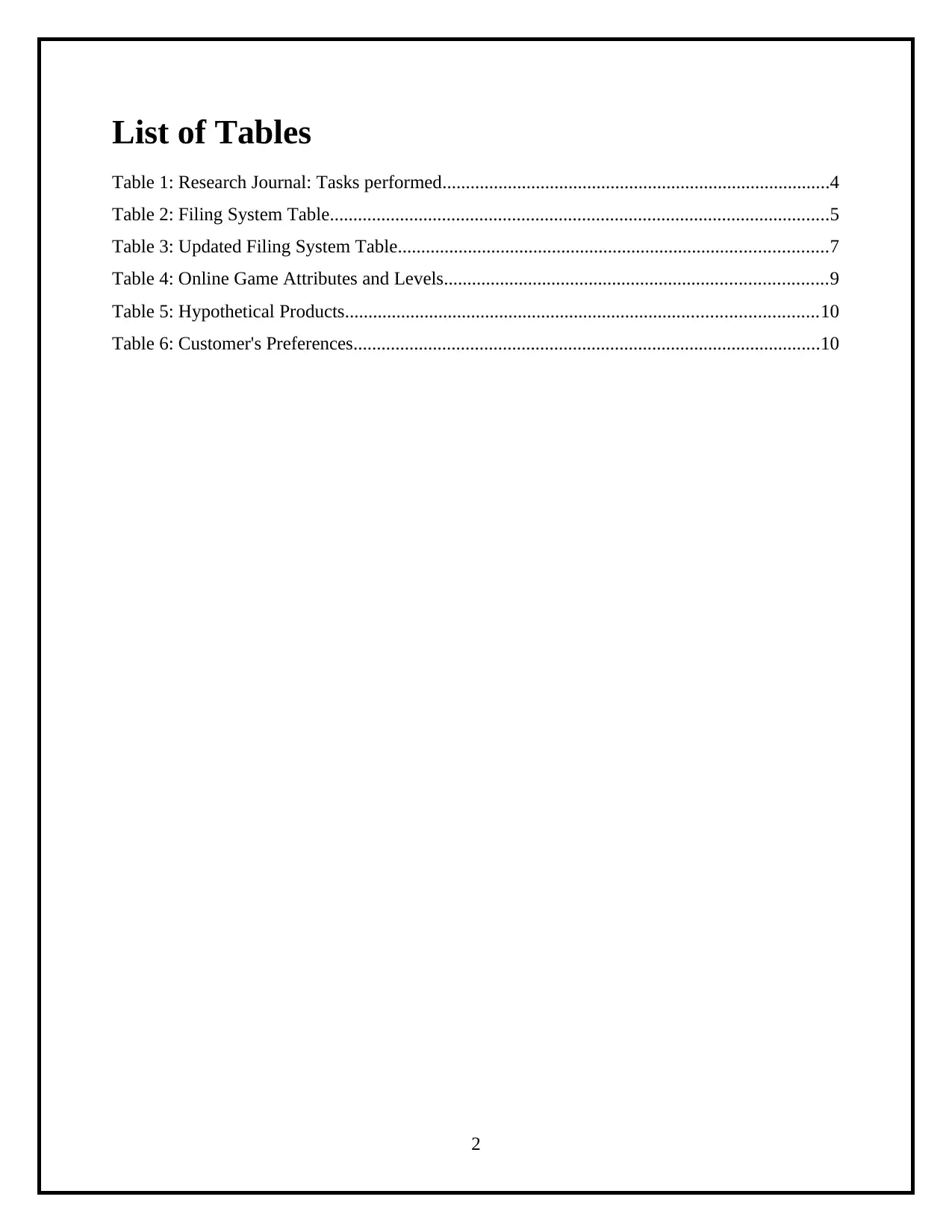
List of Tables
Table 1: Research Journal: Tasks performed...................................................................................4
Table 2: Filing System Table...........................................................................................................5
Table 3: Updated Filing System Table............................................................................................7
Table 4: Online Game Attributes and Levels..................................................................................9
Table 5: Hypothetical Products.....................................................................................................10
Table 6: Customer's Preferences....................................................................................................10
2
Table 1: Research Journal: Tasks performed...................................................................................4
Table 2: Filing System Table...........................................................................................................5
Table 3: Updated Filing System Table............................................................................................7
Table 4: Online Game Attributes and Levels..................................................................................9
Table 5: Hypothetical Products.....................................................................................................10
Table 6: Customer's Preferences....................................................................................................10
2
⊘ This is a preview!⊘
Do you want full access?
Subscribe today to unlock all pages.

Trusted by 1+ million students worldwide
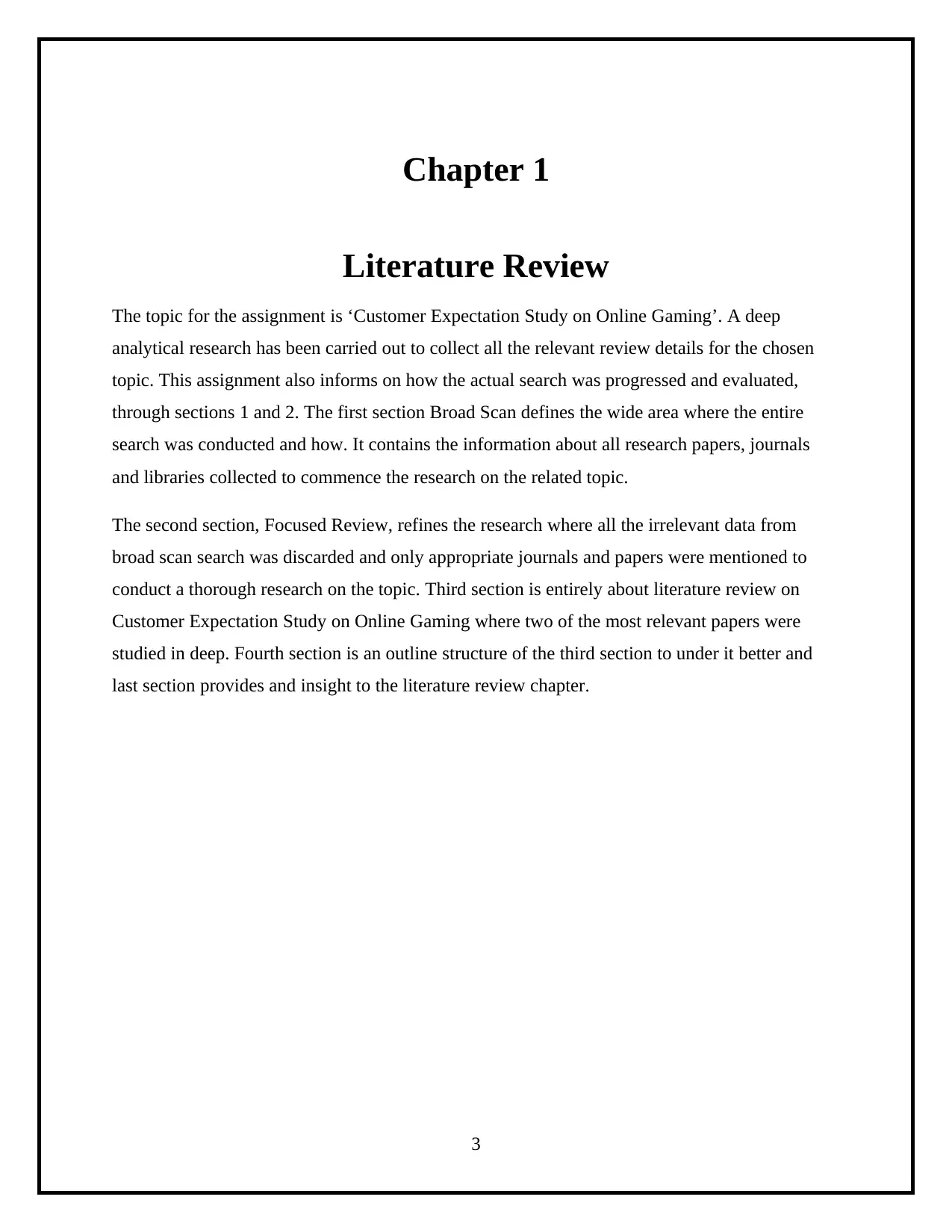
Chapter 1
Literature Review
The topic for the assignment is ‘Customer Expectation Study on Online Gaming’. A deep
analytical research has been carried out to collect all the relevant review details for the chosen
topic. This assignment also informs on how the actual search was progressed and evaluated,
through sections 1 and 2. The first section Broad Scan defines the wide area where the entire
search was conducted and how. It contains the information about all research papers, journals
and libraries collected to commence the research on the related topic.
The second section, Focused Review, refines the research where all the irrelevant data from
broad scan search was discarded and only appropriate journals and papers were mentioned to
conduct a thorough research on the topic. Third section is entirely about literature review on
Customer Expectation Study on Online Gaming where two of the most relevant papers were
studied in deep. Fourth section is an outline structure of the third section to under it better and
last section provides and insight to the literature review chapter.
3
Literature Review
The topic for the assignment is ‘Customer Expectation Study on Online Gaming’. A deep
analytical research has been carried out to collect all the relevant review details for the chosen
topic. This assignment also informs on how the actual search was progressed and evaluated,
through sections 1 and 2. The first section Broad Scan defines the wide area where the entire
search was conducted and how. It contains the information about all research papers, journals
and libraries collected to commence the research on the related topic.
The second section, Focused Review, refines the research where all the irrelevant data from
broad scan search was discarded and only appropriate journals and papers were mentioned to
conduct a thorough research on the topic. Third section is entirely about literature review on
Customer Expectation Study on Online Gaming where two of the most relevant papers were
studied in deep. Fourth section is an outline structure of the third section to under it better and
last section provides and insight to the literature review chapter.
3
Paraphrase This Document
Need a fresh take? Get an instant paraphrase of this document with our AI Paraphraser
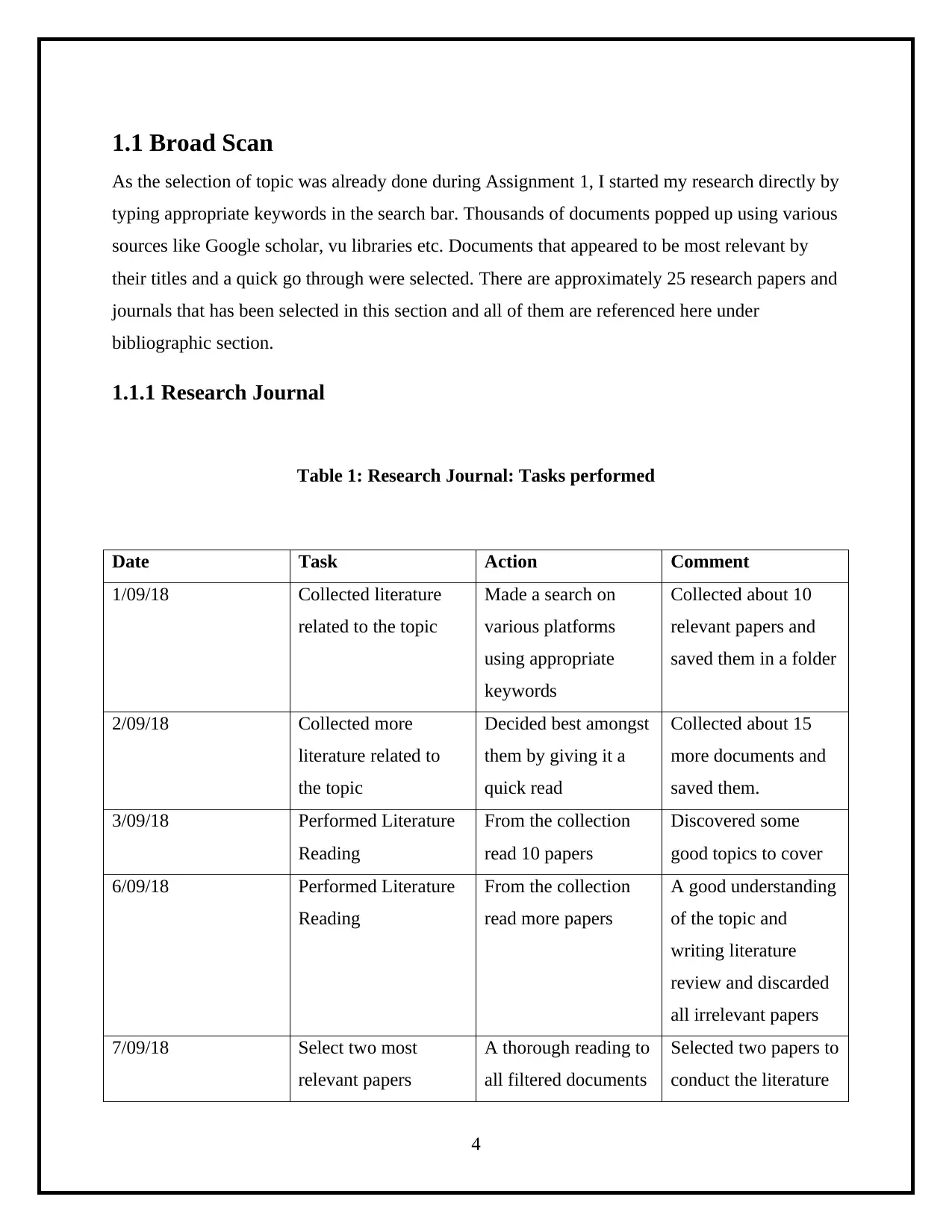
1.1 Broad Scan
As the selection of topic was already done during Assignment 1, I started my research directly by
typing appropriate keywords in the search bar. Thousands of documents popped up using various
sources like Google scholar, vu libraries etc. Documents that appeared to be most relevant by
their titles and a quick go through were selected. There are approximately 25 research papers and
journals that has been selected in this section and all of them are referenced here under
bibliographic section.
1.1.1 Research Journal
Table 1: Research Journal: Tasks performed
Date Task Action Comment
1/09/18 Collected literature
related to the topic
Made a search on
various platforms
using appropriate
keywords
Collected about 10
relevant papers and
saved them in a folder
2/09/18 Collected more
literature related to
the topic
Decided best amongst
them by giving it a
quick read
Collected about 15
more documents and
saved them.
3/09/18 Performed Literature
Reading
From the collection
read 10 papers
Discovered some
good topics to cover
6/09/18 Performed Literature
Reading
From the collection
read more papers
A good understanding
of the topic and
writing literature
review and discarded
all irrelevant papers
7/09/18 Select two most
relevant papers
A thorough reading to
all filtered documents
Selected two papers to
conduct the literature
4
As the selection of topic was already done during Assignment 1, I started my research directly by
typing appropriate keywords in the search bar. Thousands of documents popped up using various
sources like Google scholar, vu libraries etc. Documents that appeared to be most relevant by
their titles and a quick go through were selected. There are approximately 25 research papers and
journals that has been selected in this section and all of them are referenced here under
bibliographic section.
1.1.1 Research Journal
Table 1: Research Journal: Tasks performed
Date Task Action Comment
1/09/18 Collected literature
related to the topic
Made a search on
various platforms
using appropriate
keywords
Collected about 10
relevant papers and
saved them in a folder
2/09/18 Collected more
literature related to
the topic
Decided best amongst
them by giving it a
quick read
Collected about 15
more documents and
saved them.
3/09/18 Performed Literature
Reading
From the collection
read 10 papers
Discovered some
good topics to cover
6/09/18 Performed Literature
Reading
From the collection
read more papers
A good understanding
of the topic and
writing literature
review and discarded
all irrelevant papers
7/09/18 Select two most
relevant papers
A thorough reading to
all filtered documents
Selected two papers to
conduct the literature
4
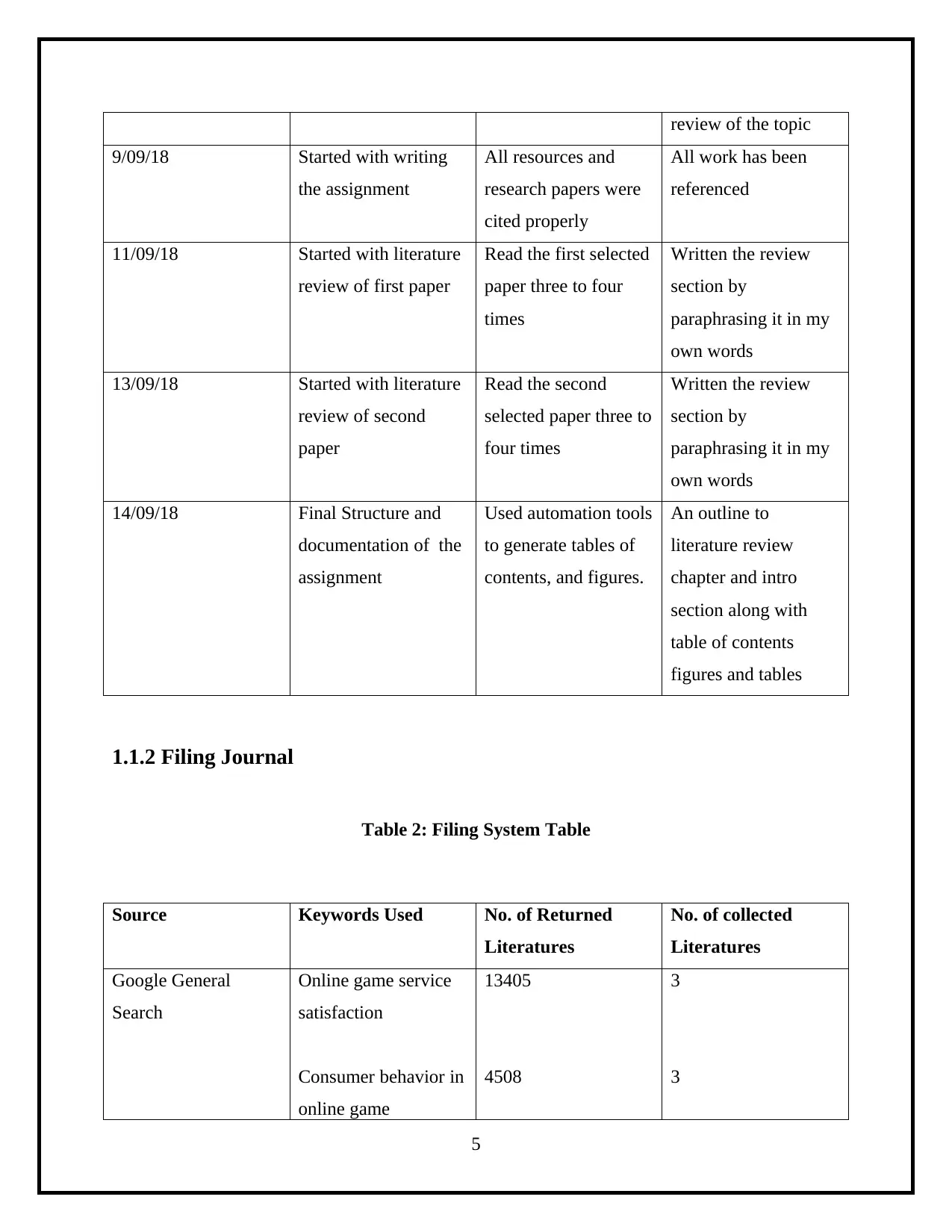
review of the topic
9/09/18 Started with writing
the assignment
All resources and
research papers were
cited properly
All work has been
referenced
11/09/18 Started with literature
review of first paper
Read the first selected
paper three to four
times
Written the review
section by
paraphrasing it in my
own words
13/09/18 Started with literature
review of second
paper
Read the second
selected paper three to
four times
Written the review
section by
paraphrasing it in my
own words
14/09/18 Final Structure and
documentation of the
assignment
Used automation tools
to generate tables of
contents, and figures.
An outline to
literature review
chapter and intro
section along with
table of contents
figures and tables
1.1.2 Filing Journal
Table 2: Filing System Table
Source Keywords Used No. of Returned
Literatures
No. of collected
Literatures
Google General
Search
Online game service
satisfaction
Consumer behavior in
online game
13405
4508
3
3
5
9/09/18 Started with writing
the assignment
All resources and
research papers were
cited properly
All work has been
referenced
11/09/18 Started with literature
review of first paper
Read the first selected
paper three to four
times
Written the review
section by
paraphrasing it in my
own words
13/09/18 Started with literature
review of second
paper
Read the second
selected paper three to
four times
Written the review
section by
paraphrasing it in my
own words
14/09/18 Final Structure and
documentation of the
assignment
Used automation tools
to generate tables of
contents, and figures.
An outline to
literature review
chapter and intro
section along with
table of contents
figures and tables
1.1.2 Filing Journal
Table 2: Filing System Table
Source Keywords Used No. of Returned
Literatures
No. of collected
Literatures
Google General
Search
Online game service
satisfaction
Consumer behavior in
online game
13405
4508
3
3
5
⊘ This is a preview!⊘
Do you want full access?
Subscribe today to unlock all pages.

Trusted by 1+ million students worldwide
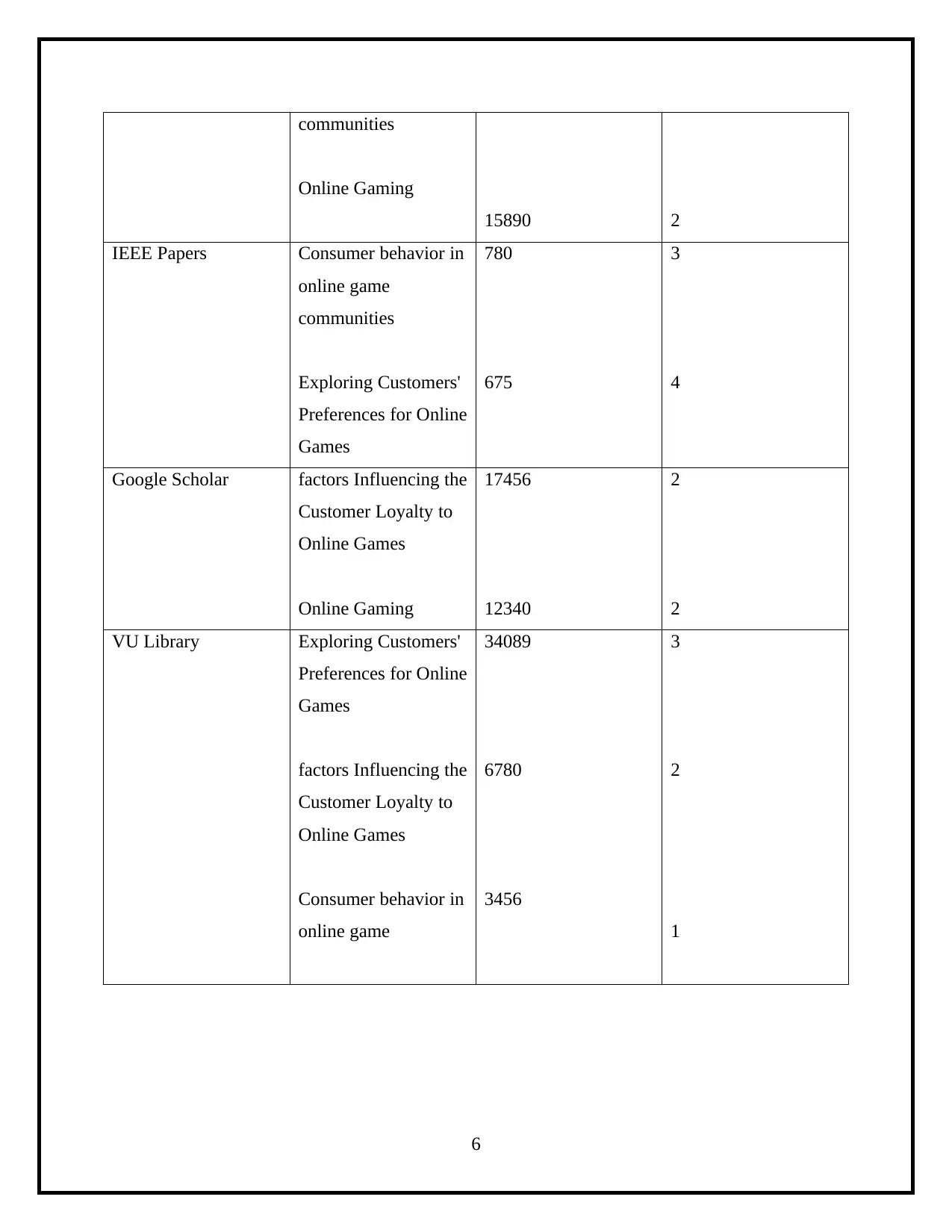
communities
Online Gaming
15890 2
IEEE Papers Consumer behavior in
online game
communities
Exploring Customers'
Preferences for Online
Games
780
675
3
4
Google Scholar factors Influencing the
Customer Loyalty to
Online Games
Online Gaming
17456
12340
2
2
VU Library Exploring Customers'
Preferences for Online
Games
factors Influencing the
Customer Loyalty to
Online Games
Consumer behavior in
online game
34089
6780
3456
3
2
1
6
Online Gaming
15890 2
IEEE Papers Consumer behavior in
online game
communities
Exploring Customers'
Preferences for Online
Games
780
675
3
4
Google Scholar factors Influencing the
Customer Loyalty to
Online Games
Online Gaming
17456
12340
2
2
VU Library Exploring Customers'
Preferences for Online
Games
factors Influencing the
Customer Loyalty to
Online Games
Consumer behavior in
online game
34089
6780
3456
3
2
1
6
Paraphrase This Document
Need a fresh take? Get an instant paraphrase of this document with our AI Paraphraser
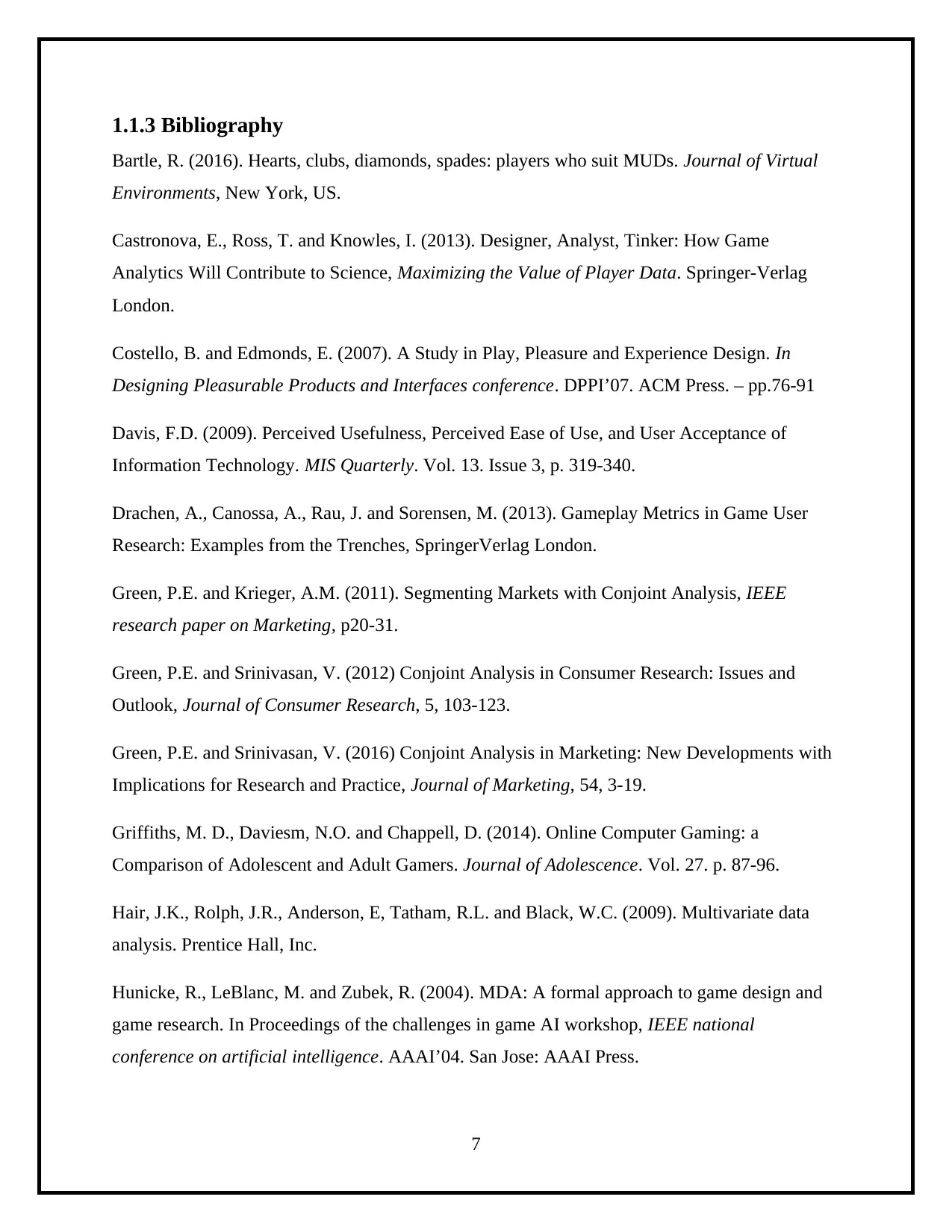
1.1.3 Bibliography
Bartle, R. (2016). Hearts, clubs, diamonds, spades: players who suit MUDs. Journal of Virtual
Environments, New York, US.
Castronova, E., Ross, T. and Knowles, I. (2013). Designer, Analyst, Tinker: How Game
Analytics Will Contribute to Science, Maximizing the Value of Player Data. Springer-Verlag
London.
Costello, B. and Edmonds, E. (2007). A Study in Play, Pleasure and Experience Design. In
Designing Pleasurable Products and Interfaces conference. DPPI’07. ACM Press. – pp.76-91
Davis, F.D. (2009). Perceived Usefulness, Perceived Ease of Use, and User Acceptance of
Information Technology. MIS Quarterly. Vol. 13. Issue 3, p. 319-340.
Drachen, A., Canossa, A., Rau, J. and Sorensen, M. (2013). Gameplay Metrics in Game User
Research: Examples from the Trenches, SpringerVerlag London.
Green, P.E. and Krieger, A.M. (2011). Segmenting Markets with Conjoint Analysis, IEEE
research paper on Marketing, p20-31.
Green, P.E. and Srinivasan, V. (2012) Conjoint Analysis in Consumer Research: Issues and
Outlook, Journal of Consumer Research, 5, 103-123.
Green, P.E. and Srinivasan, V. (2016) Conjoint Analysis in Marketing: New Developments with
Implications for Research and Practice, Journal of Marketing, 54, 3-19.
Griffiths, M. D., Daviesm, N.O. and Chappell, D. (2014). Online Computer Gaming: a
Comparison of Adolescent and Adult Gamers. Journal of Adolescence. Vol. 27. p. 87-96.
Hair, J.K., Rolph, J.R., Anderson, E, Tatham, R.L. and Black, W.C. (2009). Multivariate data
analysis. Prentice Hall, Inc.
Hunicke, R., LeBlanc, M. and Zubek, R. (2004). MDA: A formal approach to game design and
game research. In Proceedings of the challenges in game AI workshop, IEEE national
conference on artificial intelligence. AAAI’04. San Jose: AAAI Press.
7
Bartle, R. (2016). Hearts, clubs, diamonds, spades: players who suit MUDs. Journal of Virtual
Environments, New York, US.
Castronova, E., Ross, T. and Knowles, I. (2013). Designer, Analyst, Tinker: How Game
Analytics Will Contribute to Science, Maximizing the Value of Player Data. Springer-Verlag
London.
Costello, B. and Edmonds, E. (2007). A Study in Play, Pleasure and Experience Design. In
Designing Pleasurable Products and Interfaces conference. DPPI’07. ACM Press. – pp.76-91
Davis, F.D. (2009). Perceived Usefulness, Perceived Ease of Use, and User Acceptance of
Information Technology. MIS Quarterly. Vol. 13. Issue 3, p. 319-340.
Drachen, A., Canossa, A., Rau, J. and Sorensen, M. (2013). Gameplay Metrics in Game User
Research: Examples from the Trenches, SpringerVerlag London.
Green, P.E. and Krieger, A.M. (2011). Segmenting Markets with Conjoint Analysis, IEEE
research paper on Marketing, p20-31.
Green, P.E. and Srinivasan, V. (2012) Conjoint Analysis in Consumer Research: Issues and
Outlook, Journal of Consumer Research, 5, 103-123.
Green, P.E. and Srinivasan, V. (2016) Conjoint Analysis in Marketing: New Developments with
Implications for Research and Practice, Journal of Marketing, 54, 3-19.
Griffiths, M. D., Daviesm, N.O. and Chappell, D. (2014). Online Computer Gaming: a
Comparison of Adolescent and Adult Gamers. Journal of Adolescence. Vol. 27. p. 87-96.
Hair, J.K., Rolph, J.R., Anderson, E, Tatham, R.L. and Black, W.C. (2009). Multivariate data
analysis. Prentice Hall, Inc.
Hunicke, R., LeBlanc, M. and Zubek, R. (2004). MDA: A formal approach to game design and
game research. In Proceedings of the challenges in game AI workshop, IEEE national
conference on artificial intelligence. AAAI’04. San Jose: AAAI Press.
7
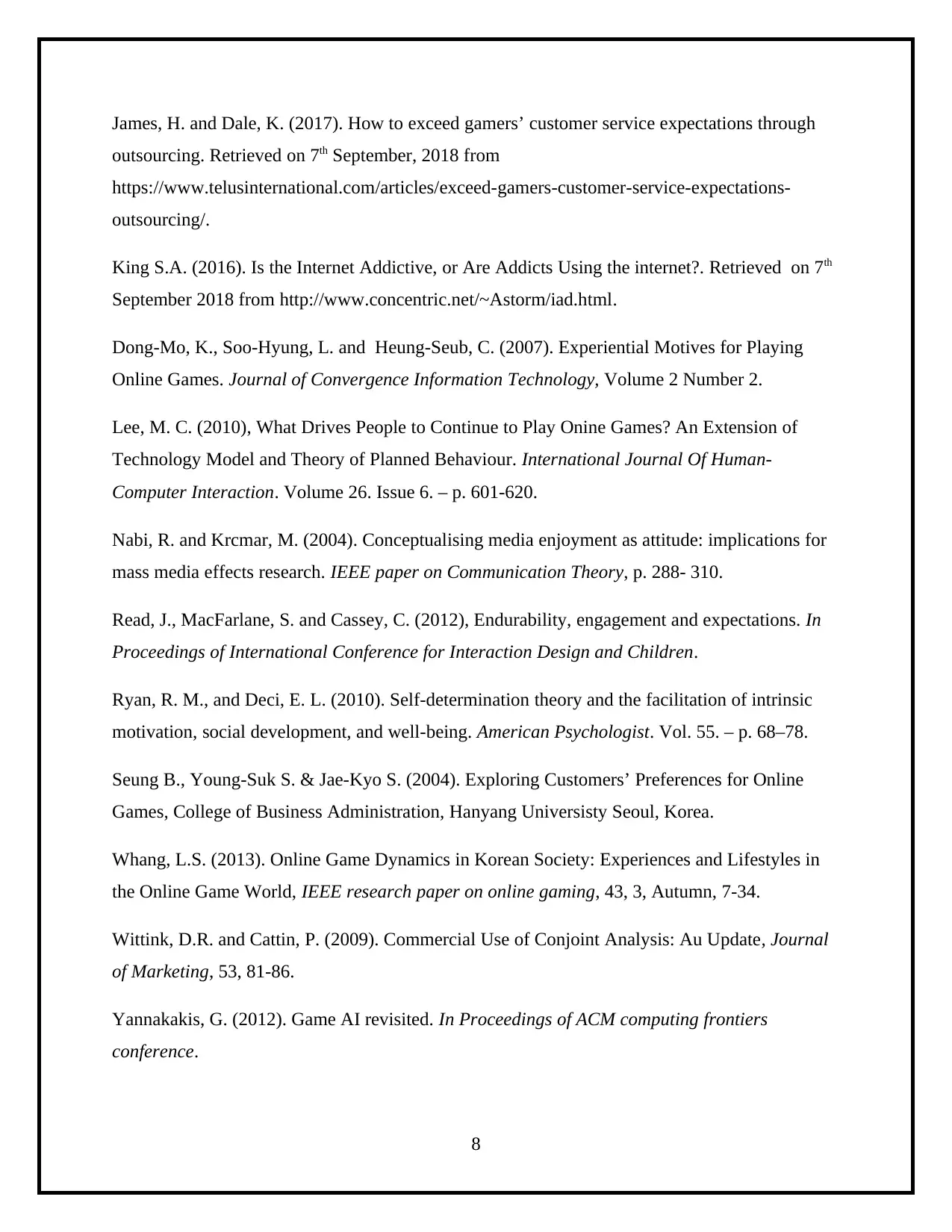
James, H. and Dale, K. (2017). How to exceed gamers’ customer service expectations through
outsourcing. Retrieved on 7th September, 2018 from
https://www.telusinternational.com/articles/exceed-gamers-customer-service-expectations-
outsourcing/.
King S.A. (2016). Is the Internet Addictive, or Are Addicts Using the internet?. Retrieved on 7th
September 2018 from http://www.concentric.net/~Astorm/iad.html.
Dong-Mo, K., Soo-Hyung, L. and Heung-Seub, C. (2007). Experiential Motives for Playing
Online Games. Journal of Convergence Information Technology, Volume 2 Number 2.
Lee, M. C. (2010), What Drives People to Continue to Play Onine Games? An Extension of
Technology Model and Theory of Planned Behaviour. International Journal Of Human-
Computer Interaction. Volume 26. Issue 6. – p. 601-620.
Nabi, R. and Krcmar, M. (2004). Conceptualising media enjoyment as attitude: implications for
mass media effects research. IEEE paper on Communication Theory, p. 288- 310.
Read, J., MacFarlane, S. and Cassey, C. (2012), Endurability, engagement and expectations. In
Proceedings of International Conference for Interaction Design and Children.
Ryan, R. M., and Deci, E. L. (2010). Self-determination theory and the facilitation of intrinsic
motivation, social development, and well-being. American Psychologist. Vol. 55. – p. 68–78.
Seung B., Young-Suk S. & Jae-Kyo S. (2004). Exploring Customers’ Preferences for Online
Games, College of Business Administration, Hanyang Universisty Seoul, Korea.
Whang, L.S. (2013). Online Game Dynamics in Korean Society: Experiences and Lifestyles in
the Online Game World, IEEE research paper on online gaming, 43, 3, Autumn, 7-34.
Wittink, D.R. and Cattin, P. (2009). Commercial Use of Conjoint Analysis: Au Update, Journal
of Marketing, 53, 81-86.
Yannakakis, G. (2012). Game AI revisited. In Proceedings of ACM computing frontiers
conference.
8
outsourcing. Retrieved on 7th September, 2018 from
https://www.telusinternational.com/articles/exceed-gamers-customer-service-expectations-
outsourcing/.
King S.A. (2016). Is the Internet Addictive, or Are Addicts Using the internet?. Retrieved on 7th
September 2018 from http://www.concentric.net/~Astorm/iad.html.
Dong-Mo, K., Soo-Hyung, L. and Heung-Seub, C. (2007). Experiential Motives for Playing
Online Games. Journal of Convergence Information Technology, Volume 2 Number 2.
Lee, M. C. (2010), What Drives People to Continue to Play Onine Games? An Extension of
Technology Model and Theory of Planned Behaviour. International Journal Of Human-
Computer Interaction. Volume 26. Issue 6. – p. 601-620.
Nabi, R. and Krcmar, M. (2004). Conceptualising media enjoyment as attitude: implications for
mass media effects research. IEEE paper on Communication Theory, p. 288- 310.
Read, J., MacFarlane, S. and Cassey, C. (2012), Endurability, engagement and expectations. In
Proceedings of International Conference for Interaction Design and Children.
Ryan, R. M., and Deci, E. L. (2010). Self-determination theory and the facilitation of intrinsic
motivation, social development, and well-being. American Psychologist. Vol. 55. – p. 68–78.
Seung B., Young-Suk S. & Jae-Kyo S. (2004). Exploring Customers’ Preferences for Online
Games, College of Business Administration, Hanyang Universisty Seoul, Korea.
Whang, L.S. (2013). Online Game Dynamics in Korean Society: Experiences and Lifestyles in
the Online Game World, IEEE research paper on online gaming, 43, 3, Autumn, 7-34.
Wittink, D.R. and Cattin, P. (2009). Commercial Use of Conjoint Analysis: Au Update, Journal
of Marketing, 53, 81-86.
Yannakakis, G. (2012). Game AI revisited. In Proceedings of ACM computing frontiers
conference.
8
⊘ This is a preview!⊘
Do you want full access?
Subscribe today to unlock all pages.

Trusted by 1+ million students worldwide
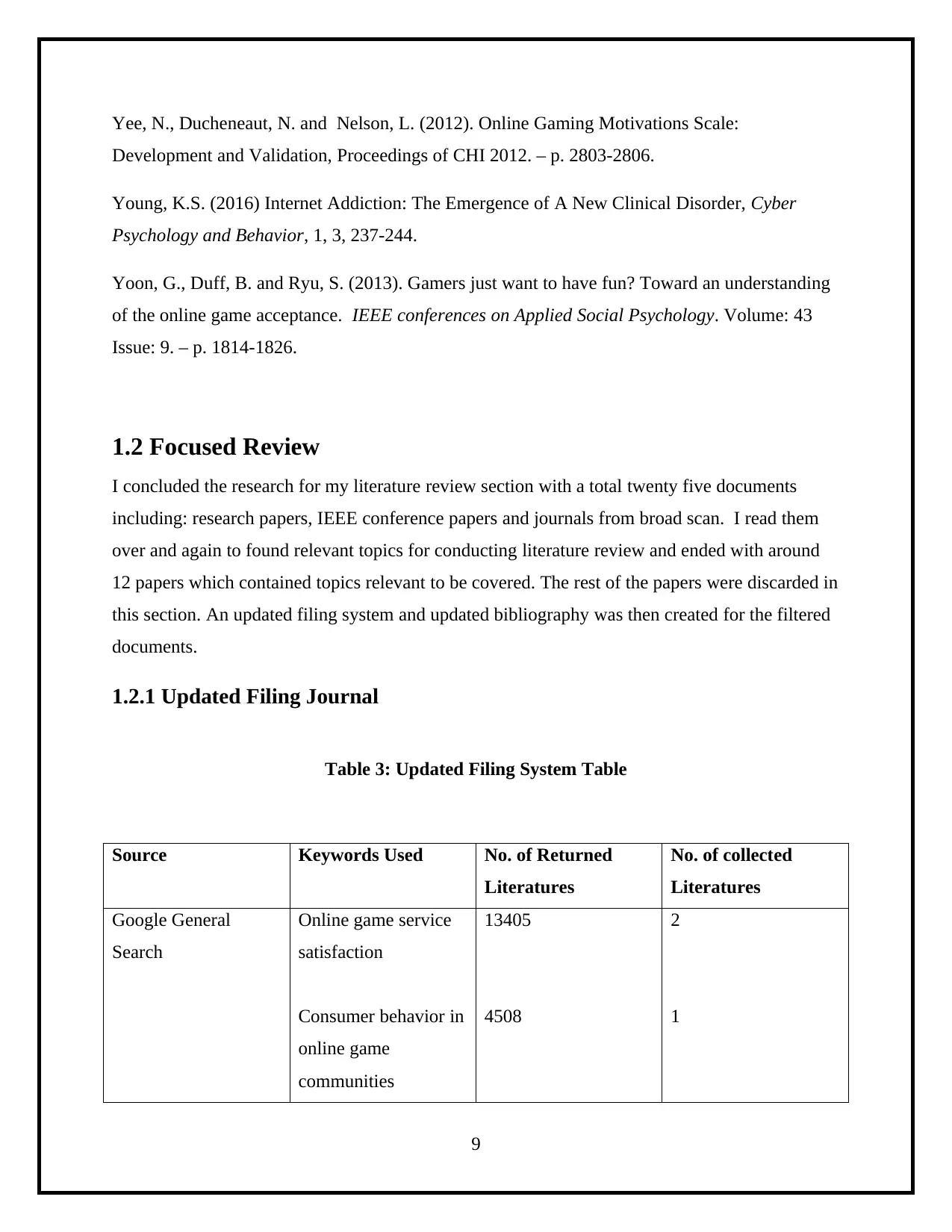
Yee, N., Ducheneaut, N. and Nelson, L. (2012). Online Gaming Motivations Scale:
Development and Validation, Proceedings of CHI 2012. – p. 2803-2806.
Young, K.S. (2016) Internet Addiction: The Emergence of A New Clinical Disorder, Cyber
Psychology and Behavior, 1, 3, 237-244.
Yoon, G., Duff, B. and Ryu, S. (2013). Gamers just want to have fun? Toward an understanding
of the online game acceptance. IEEE conferences on Applied Social Psychology. Volume: 43
Issue: 9. – p. 1814-1826.
1.2 Focused Review
I concluded the research for my literature review section with a total twenty five documents
including: research papers, IEEE conference papers and journals from broad scan. I read them
over and again to found relevant topics for conducting literature review and ended with around
12 papers which contained topics relevant to be covered. The rest of the papers were discarded in
this section. An updated filing system and updated bibliography was then created for the filtered
documents.
1.2.1 Updated Filing Journal
Table 3: Updated Filing System Table
Source Keywords Used No. of Returned
Literatures
No. of collected
Literatures
Google General
Search
Online game service
satisfaction
Consumer behavior in
online game
communities
13405
4508
2
1
9
Development and Validation, Proceedings of CHI 2012. – p. 2803-2806.
Young, K.S. (2016) Internet Addiction: The Emergence of A New Clinical Disorder, Cyber
Psychology and Behavior, 1, 3, 237-244.
Yoon, G., Duff, B. and Ryu, S. (2013). Gamers just want to have fun? Toward an understanding
of the online game acceptance. IEEE conferences on Applied Social Psychology. Volume: 43
Issue: 9. – p. 1814-1826.
1.2 Focused Review
I concluded the research for my literature review section with a total twenty five documents
including: research papers, IEEE conference papers and journals from broad scan. I read them
over and again to found relevant topics for conducting literature review and ended with around
12 papers which contained topics relevant to be covered. The rest of the papers were discarded in
this section. An updated filing system and updated bibliography was then created for the filtered
documents.
1.2.1 Updated Filing Journal
Table 3: Updated Filing System Table
Source Keywords Used No. of Returned
Literatures
No. of collected
Literatures
Google General
Search
Online game service
satisfaction
Consumer behavior in
online game
communities
13405
4508
2
1
9
Paraphrase This Document
Need a fresh take? Get an instant paraphrase of this document with our AI Paraphraser
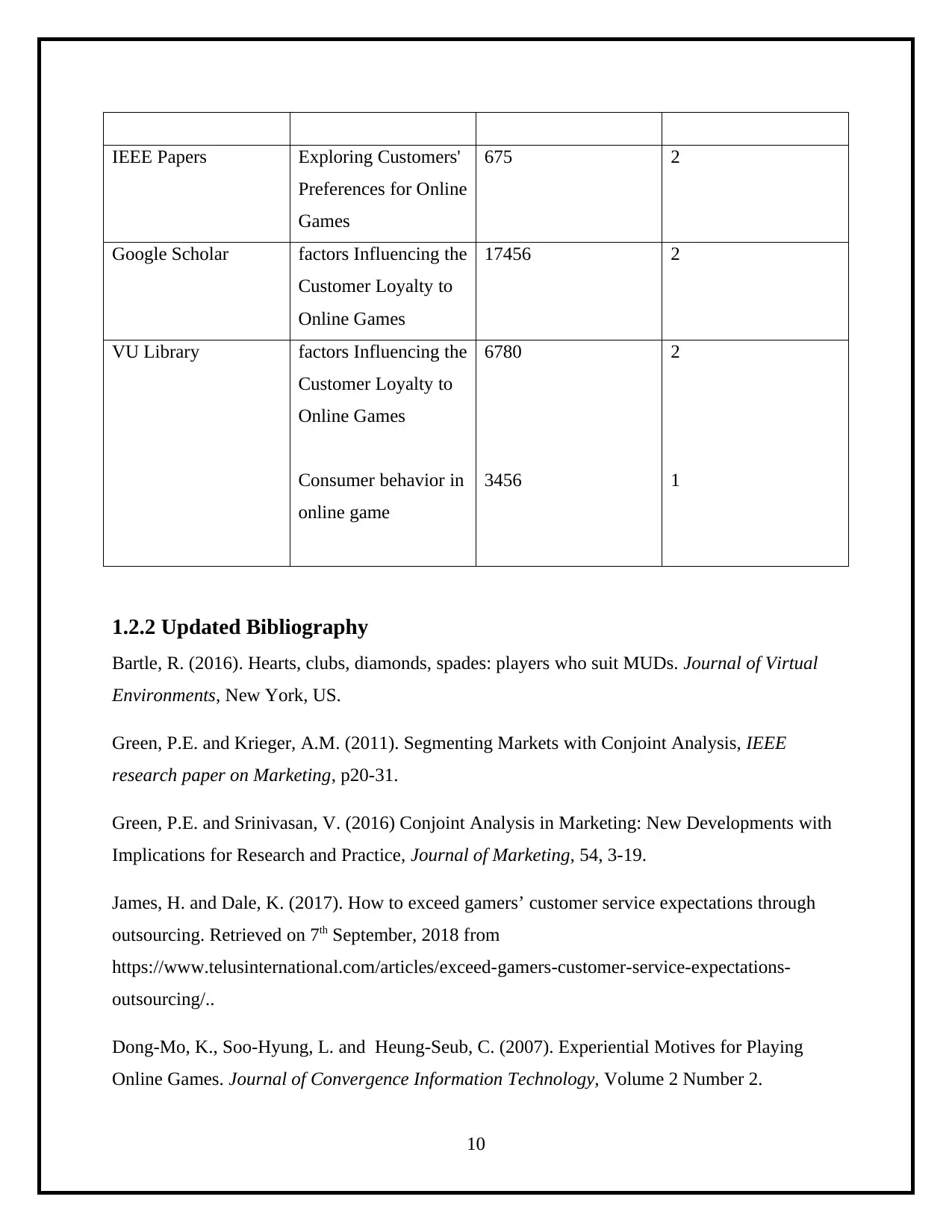
IEEE Papers Exploring Customers'
Preferences for Online
Games
675 2
Google Scholar factors Influencing the
Customer Loyalty to
Online Games
17456 2
VU Library factors Influencing the
Customer Loyalty to
Online Games
Consumer behavior in
online game
6780
3456
2
1
1.2.2 Updated Bibliography
Bartle, R. (2016). Hearts, clubs, diamonds, spades: players who suit MUDs. Journal of Virtual
Environments, New York, US.
Green, P.E. and Krieger, A.M. (2011). Segmenting Markets with Conjoint Analysis, IEEE
research paper on Marketing, p20-31.
Green, P.E. and Srinivasan, V. (2016) Conjoint Analysis in Marketing: New Developments with
Implications for Research and Practice, Journal of Marketing, 54, 3-19.
James, H. and Dale, K. (2017). How to exceed gamers’ customer service expectations through
outsourcing. Retrieved on 7th September, 2018 from
https://www.telusinternational.com/articles/exceed-gamers-customer-service-expectations-
outsourcing/..
Dong-Mo, K., Soo-Hyung, L. and Heung-Seub, C. (2007). Experiential Motives for Playing
Online Games. Journal of Convergence Information Technology, Volume 2 Number 2.
10
Preferences for Online
Games
675 2
Google Scholar factors Influencing the
Customer Loyalty to
Online Games
17456 2
VU Library factors Influencing the
Customer Loyalty to
Online Games
Consumer behavior in
online game
6780
3456
2
1
1.2.2 Updated Bibliography
Bartle, R. (2016). Hearts, clubs, diamonds, spades: players who suit MUDs. Journal of Virtual
Environments, New York, US.
Green, P.E. and Krieger, A.M. (2011). Segmenting Markets with Conjoint Analysis, IEEE
research paper on Marketing, p20-31.
Green, P.E. and Srinivasan, V. (2016) Conjoint Analysis in Marketing: New Developments with
Implications for Research and Practice, Journal of Marketing, 54, 3-19.
James, H. and Dale, K. (2017). How to exceed gamers’ customer service expectations through
outsourcing. Retrieved on 7th September, 2018 from
https://www.telusinternational.com/articles/exceed-gamers-customer-service-expectations-
outsourcing/..
Dong-Mo, K., Soo-Hyung, L. and Heung-Seub, C. (2007). Experiential Motives for Playing
Online Games. Journal of Convergence Information Technology, Volume 2 Number 2.
10
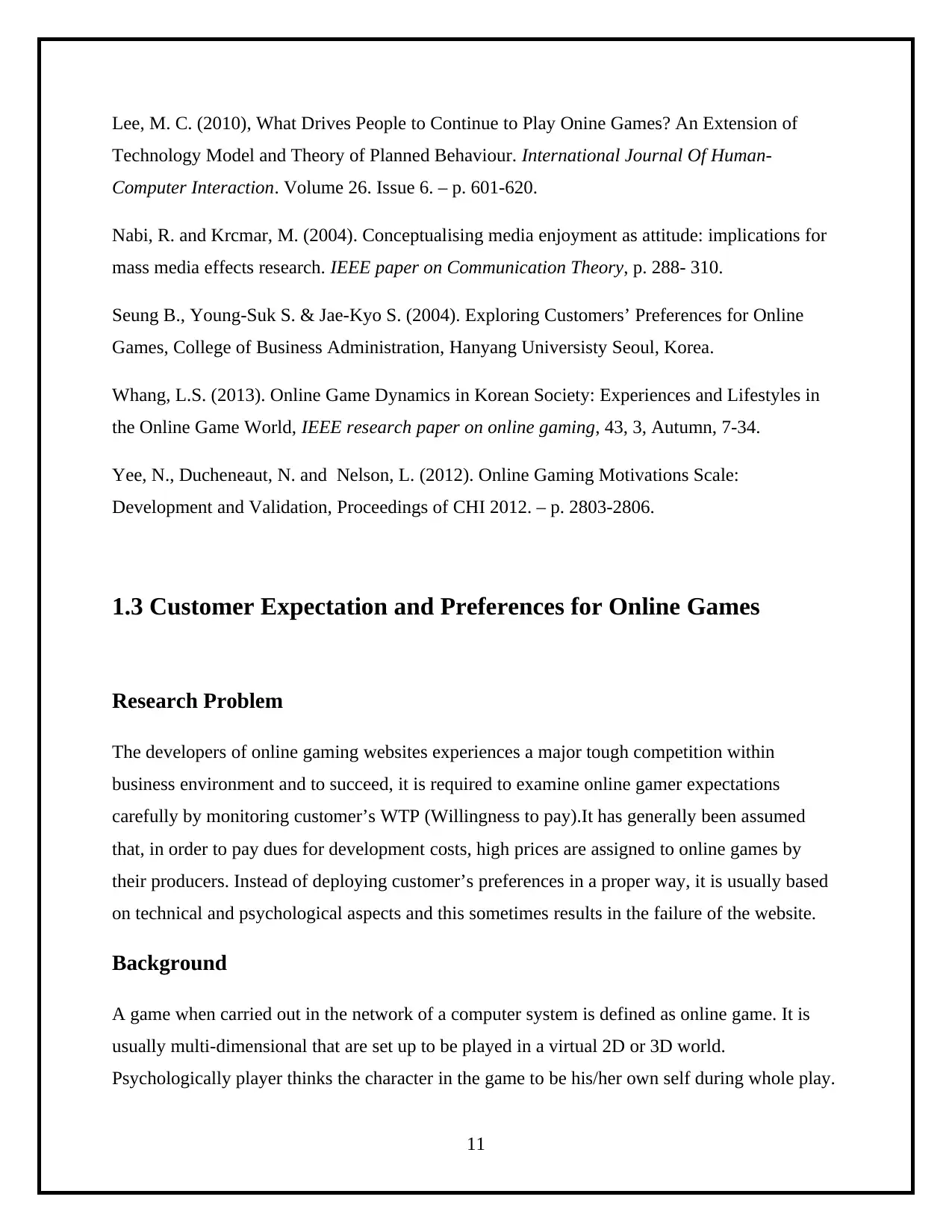
Lee, M. C. (2010), What Drives People to Continue to Play Onine Games? An Extension of
Technology Model and Theory of Planned Behaviour. International Journal Of Human-
Computer Interaction. Volume 26. Issue 6. – p. 601-620.
Nabi, R. and Krcmar, M. (2004). Conceptualising media enjoyment as attitude: implications for
mass media effects research. IEEE paper on Communication Theory, p. 288- 310.
Seung B., Young-Suk S. & Jae-Kyo S. (2004). Exploring Customers’ Preferences for Online
Games, College of Business Administration, Hanyang Universisty Seoul, Korea.
Whang, L.S. (2013). Online Game Dynamics in Korean Society: Experiences and Lifestyles in
the Online Game World, IEEE research paper on online gaming, 43, 3, Autumn, 7-34.
Yee, N., Ducheneaut, N. and Nelson, L. (2012). Online Gaming Motivations Scale:
Development and Validation, Proceedings of CHI 2012. – p. 2803-2806.
1.3 Customer Expectation and Preferences for Online Games
Research Problem
The developers of online gaming websites experiences a major tough competition within
business environment and to succeed, it is required to examine online gamer expectations
carefully by monitoring customer’s WTP (Willingness to pay).It has generally been assumed
that, in order to pay dues for development costs, high prices are assigned to online games by
their producers. Instead of deploying customer’s preferences in a proper way, it is usually based
on technical and psychological aspects and this sometimes results in the failure of the website.
Background
A game when carried out in the network of a computer system is defined as online game. It is
usually multi-dimensional that are set up to be played in a virtual 2D or 3D world.
Psychologically player thinks the character in the game to be his/her own self during whole play.
11
Technology Model and Theory of Planned Behaviour. International Journal Of Human-
Computer Interaction. Volume 26. Issue 6. – p. 601-620.
Nabi, R. and Krcmar, M. (2004). Conceptualising media enjoyment as attitude: implications for
mass media effects research. IEEE paper on Communication Theory, p. 288- 310.
Seung B., Young-Suk S. & Jae-Kyo S. (2004). Exploring Customers’ Preferences for Online
Games, College of Business Administration, Hanyang Universisty Seoul, Korea.
Whang, L.S. (2013). Online Game Dynamics in Korean Society: Experiences and Lifestyles in
the Online Game World, IEEE research paper on online gaming, 43, 3, Autumn, 7-34.
Yee, N., Ducheneaut, N. and Nelson, L. (2012). Online Gaming Motivations Scale:
Development and Validation, Proceedings of CHI 2012. – p. 2803-2806.
1.3 Customer Expectation and Preferences for Online Games
Research Problem
The developers of online gaming websites experiences a major tough competition within
business environment and to succeed, it is required to examine online gamer expectations
carefully by monitoring customer’s WTP (Willingness to pay).It has generally been assumed
that, in order to pay dues for development costs, high prices are assigned to online games by
their producers. Instead of deploying customer’s preferences in a proper way, it is usually based
on technical and psychological aspects and this sometimes results in the failure of the website.
Background
A game when carried out in the network of a computer system is defined as online game. It is
usually multi-dimensional that are set up to be played in a virtual 2D or 3D world.
Psychologically player thinks the character in the game to be his/her own self during whole play.
11
⊘ This is a preview!⊘
Do you want full access?
Subscribe today to unlock all pages.

Trusted by 1+ million students worldwide
1 out of 18
Related Documents
Your All-in-One AI-Powered Toolkit for Academic Success.
+13062052269
info@desklib.com
Available 24*7 on WhatsApp / Email
![[object Object]](/_next/static/media/star-bottom.7253800d.svg)
Unlock your academic potential
Copyright © 2020–2025 A2Z Services. All Rights Reserved. Developed and managed by ZUCOL.





